Joe R. Lansdale is one of the most prolific writers in any genre. He’s written everything from horror to crime fiction, historical fiction and even some non-fiction. He’s also written a bunch of comics (like the excellent Jonah Hex series for DC/Vertigo) and is a die-hard comics fan. With that in mind, we at Monkeys Fighting Robots tapped Champion Joe (as his fans call him) for a chat about what else but comics! Read on and enjoy.
Monkeys Fighting Robots: Joe, first of all, thanks for taking the time to talk to us during this national crisis. How are you and yours holding up? As a writer has social distancing changed your day to day life?
Joe R. Lansdale: We are holding up very well. I hate it for others, but for us, it’s really no different than when there isn’t a pandemic. We’re home as usual, and I write in the mornings as usual. I always read, but I might be reading a hair more, and we watch films. I exercise at home. Only thing missing is my martial arts class that I teach. I only teach private lessons these days, but I miss that. I do travel from time to time for fun or for business, so we’re not doing that, of course. Otherwise, nothing is really different for us. I’m one of those peculiar people who likes being with people, but I like being home with my wife and a routine as well. When the virus passes, I will be glad to go to the bookstore and visit with people, and we have a couple of trips we’d like to make, but again, for us, it really isn’t bad. We have food stocks anyway, just because we tend to do that, and of course, we have the essential, toilet paper. Special items our son picks up for us and delivers. He goes early in the morning, dressed in his mask, looking like a bandit, and he buys us anything we might need once or twice a week, but we don’t need much. Thanks for asking. I hope you are well.
MFR ON YOUTUBE (latest video)
Help us reach 5K Subs!
MFR: I’m holding on strong, thanks for asking! So apart from being an acclaimed novelist, short-story writer and screenwriter, you have also written many comics. What was your very first comic book writing?
JL: My first comic gig was BLOOD AND SHADOWS. It was an original comics I wrote and Mark Nelson illustrated. Only problem was, Mark was slow. So by the time he finished I had written and seen published TWO GUN MOJO, the Jonah Hex comic. That did great. BLOOD AND SHADOWS finally came out, but by then the wind had blown out of its sails and it never got the attention it deserves. It’s creator-owned, so someday it may see the light of day again.
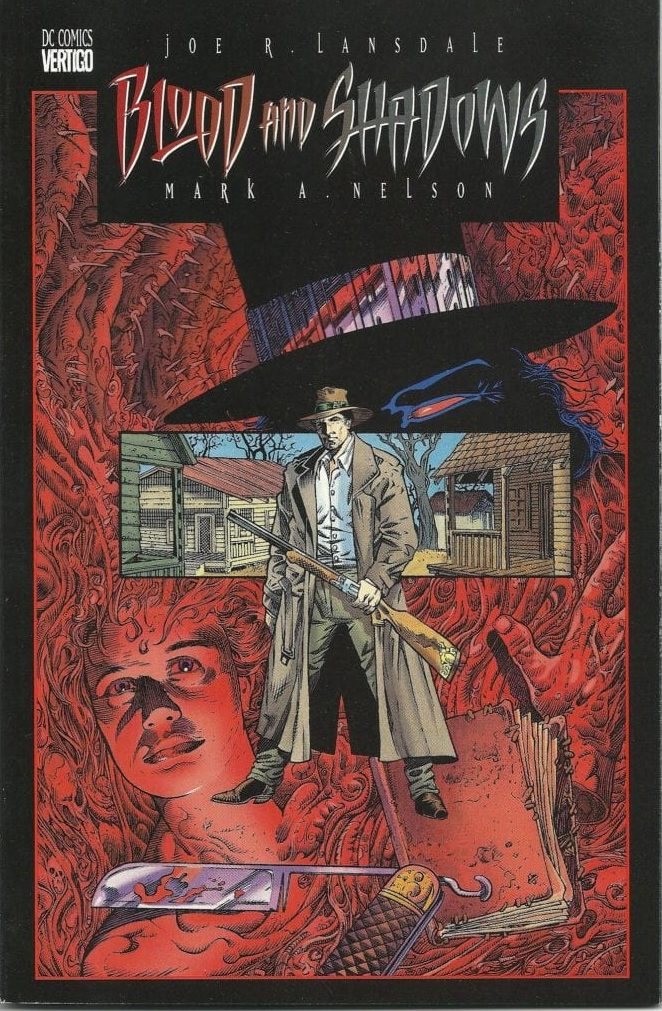
MFR: How do you approach writing a comic book as compared to a short story, or prose piece?
JL: I show up. It used to seem very different for each concern, but less so now. I do have to spend a day or two becoming comfortable with the comic or screenplay format, but then it’s about telling the story in that form, and story is the thing. I also try to write scripts that do more than tell you what happens next, but are fun to read. Prose is always natural for me, as I do a lot more of it, but comics and screenplays after that initial readjustment to form, are pretty much the same. Scripts have the time limit factor, or in the case of comics, the page limit factor. Tim Truman and I did a Hex series where we started out doing five comics, but they cut it to four, so I always felt it was truncated more than I liked. So there are limitations like that. Requested short stories can have a limit, but mostly they don’t have a drop-dead number. Comics do have that as far as page count goes, so that’s something to keep in mind and the thing I have the hardest time with.
MFR: Were comics a huge influence for you growing up? How about as an adult?
JL: I started reading comics in the fifties, and they are to this day the most important thing, along with parental encouragement, that led me to my career, and for that I am deeply grateful. Like most kids, it was the superhero stuff that excited me. I read the kid comics, the ones with talking animals, Casper the Ghost, Hot Stuff, and so on, but it was Superman who moved me first, and then I found Batman, and that was a sure-fire fit for me. I read all the DC comics heroes. Loved The Flash, Wonder Woman, and I read comics and collected them right on up until I was sixteen. And during that time I also read Classics Illustrated, which are the flip side of comics. They led me to reading a lot of the books they were based on. They have been revived, and they are reprinting and adding new comics to their line, and I buy them. I read them religiously as a kid. They led me to so many books, and since I never graduated at the University, they were a great source of my education. Without them there are so many novels and stories I wouldn’t have discovered. There are other influences, early television shows, all the reruns they did of Hopalong Cassidy, as well as new shows they made for TV. The Superman TV show, Lone Ranger, showing old serials like Flash Gordon and Buck Rogers. And the Tarzan movies were a big influence. But that’s getting off the comic subject a bit. Bottom line, they are what made me want to be a writer. I was trying to write and draw my own comics when I was four years old. My mother stapled them for me after I finished. As an adult, I read fewer comics. Like a lot of teenagers, I was dating and learning about myself. I was reading still, but comics were less and less a part of it. I would now and again buy a batch, as everything wasn’t continued. The stretched out stories that went issues and crossed over to other comics, sort of sucked the wind out of it for me in the nineties. But before that I would read them in patches, so to speak. Friends would suggest a run of comics, and then I would buy the whole run, so as not to wait for each issue. I could read a comic in fifteen to twenty minutes, so I preferred to have the whole storyline to sit down with. But I wasn’t reading them nearly as much by the time I was sixteen, and only begin to pick them up on a regular basis at the end of the eighties and into the nineties, and then, as I said, the multiple crossovers burned me out. I read a number of comics that weren’t superhero comics during the nineties, and then I dried up on the new ones for a while, even though I was writing comics. In the last ten years, I’ve gone back to reading a few new superhero comics, but the stuff I’ve really enjoyed, are comics like Capote in Kansas, and the To Kill A Mockingbird adaptation, Richard Stark Parker novel adaptations–there weren’t many, as it’s a long series. SAVAGE SEASON based on a novel by me was adapted but printed way too dark, but I enjoyed reading the artist’s interpretation. It was almost exactly the novel. MUCHO MOJO has been done, and it’ll be out in the wild eventually. What I really enjoy reading these days is rereading the DC archives, the ones before I was reading comics, the ones during my time growing up, the Silver Age, as well as gatherings of later periods. I buy nearly DC exclusively. Marvel was better in the sixties, but DC caught up, and though I like Marvel, it was always the DC characters that thrilled me. I buy a lot of old comics I used to read that have been collected. Stuff like Brothers of the Spear, Tarzan, Korak, anything to do with John Carter of Mars, and I’m once again buying the Classics Illustrated. I order a few every few months, and they are a treat.
MFR: Do you have a favorite comic creative team? A favorite writer or artist?
JL: If Tim Truman is involved in a comic, with anyone, I try and read those. I loved a lot of different comics, so I don’t know if I had a favorite team. Gardner Fox was always a name I looked for when I started seeing his name on comics. The Julie Schwartz edited comics with so many different creators were really important to me when I was young. I got to know Julie and we became friendly. It was quite an honor for me. The comics he edited were important to my childhood, and the making of my career.
MFR: Do you have a favorite comic book character?
JL: Batman. Duh.
MFR: Did you have a favorite title?
JL: I still love Batman, though I don’t read the comics regularly. I watch animated films with Batman in them, and I wrote for Batman the Animated Series, as well as wrote the script for Son of Batman. The animated series is a highlight of my career. It was like being a kid again, but with adult sensibilities. That is my favorite version of Batman, comics, film, or otherwise. I also wrote a plot outline, or that’s how I was credited, for a Superman episode. I wrote a stand-alone, unnamed Jonah Hex short, that was on the blu-ray of Under the Red Hood, and was in a DVD collection of short animated films about a variety of DC characters. I love writing for animation and would like to do more of it.
MFR: I actually discovered you through comics, in a back door kind of way. I first read Preacher in trade and the edition of volume one I had contained a forward by you. I was so taken by how you wrote about the comic that I looked up the rest of your work and read the first ‘Hap & Leonard’, Savage Season, novel shortly after. How did you end up writing that forward to Preacher?
JL: Garth was a fan of my Jonah Hex comics, and he and DC thought I’d be the right person to write it since I was a reader of the comics. It was a lot of fun, and interestingly enough, a lot of readers tell me they came to my work through that introduction, or through the comics I wrote.
MFR: You mentioned Tim Truman a few times. I wanted to get into your relationship with Tim, who I think is one of the best artists in the industry. How did you first get linked up with Tim? Were you a fan of his work like Grim Jack or Scout?
JL: I love Tim. He’s a brother. DC comics put us together. I think Tim had read something of mine and suggested it. I’m not certain, to be honest, but it is always great fun to work with Tim. There are a lot of great artists out there, but Tim is a great one with a unique style that really knows how to tell a story through his art. They aren’t just pictures in panels, they manage to tell the story by the way they are constructed. He’s my favorite artist to work with, and my favorite comic book artist, period.
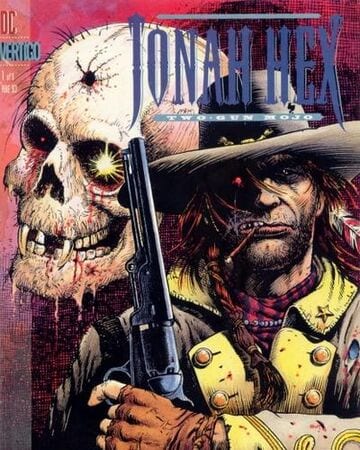
MFR: How did the development of Jonah Hex: Two Gun Mojo come about?
JL: That was Tim and DC, I think. They teamed us up because as someone said: “He draws like you write”.
MFR: What led to the sequel, Riders of The Worm and Such?
JL: Popularity of the first series of Hex comics, TWO-GUN MOJO. Success breeds sequels. I like all of the ones we did, but the first, TWO-GUN MOJO is my favorite, hands down. Each time we did a Hex series we tried to do something different with it.
MFR: Now you guys also worked on Topp’s Lone Ranger & Tonto series in the 90s. What was like that? Was it working on Hex that led to that gig?
JL: Topps was trying out comics, and Hex led us to that gig. I actually wrote two scripts for the Lone Ranger, but by the second Tim had to move on as he had another gig, the artist who worked with me on the second was great, Ted Naifeh. It hit right when Topps decided it was cutting back on comics, perhaps cutting them out altogether, I don’t remember exactly. Anyway, that one, which was a Gung-fu Western in San Francisco Chinatown, was never published.
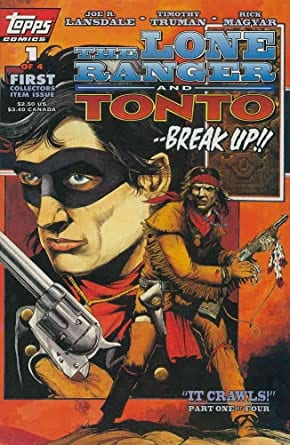
MFR: One of my personal favorite comics of yours is Dark Horse Comics Dead In The West adaptation, which was illustrated by Jack Johnson (Jaxon). Johnson who has a history that goes back to underground comics as, well drawing historical and war comics. Did you have a choice in him as an artist? Were you aware of his work?
JL: I always liked Jack’s stylized work. I knew Jack a little, and my friend Neal Barrett Jr. did the adaptation. It was cool. Would love to see a new version of it done. I did have a choice, and I was aware of his underground work. I read a few underground comics here and there and thought it would be an interesting idea. It was.
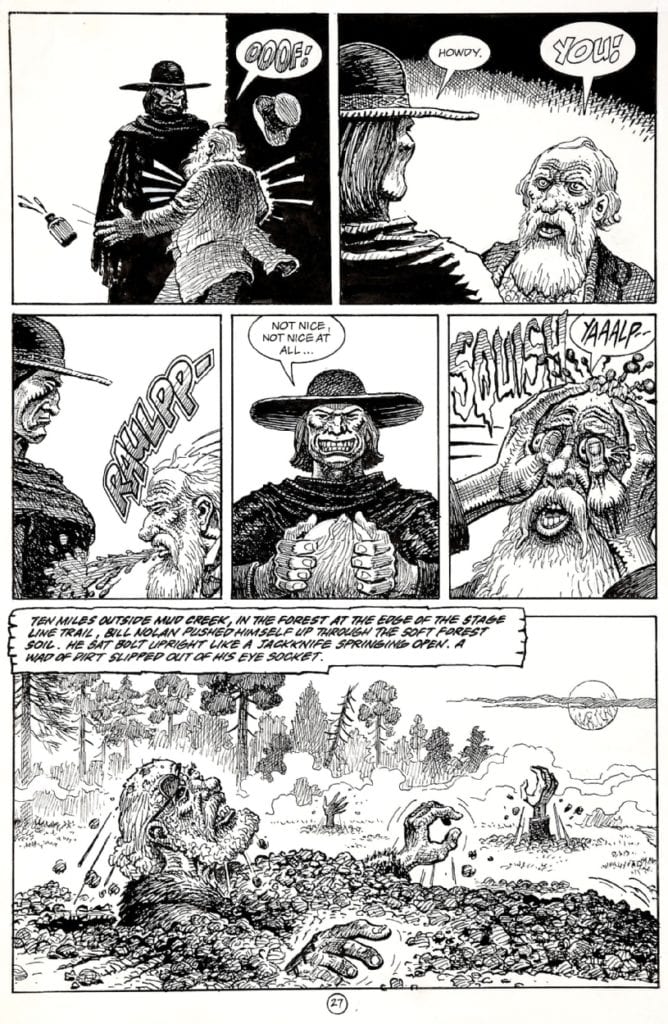
MFR: Avatar has also adapted some of your work in the past, what was it like working with them?
JL: We made a deal, they did the comics. Pretty much it. I liked the comics, though the artwork, good as it was, sort of got monotonous on THE DRIVE-IN. Good stuff, but being more suggestive than specific, the white space began to feel like a brain wound after a bit. Again, that’s not the artist, it’s just that the sort of art wears without color over long spaces. I like black and white a lot, but most comics need color. That’s one of the tools that makes them comics. Film black and white is a different matter, and certainly, specific comics in black and white are great, but if there was a comic that needed to be in moody colors, it was THE DRIVE-IN.
MFR: How involved are you in those comic adaptations of your work?
JL: I was very involved in some, less in others. BY BIZARRE HAND was a comic series based on my stories, first done by Dark Horse, later by Avatar, who I think added a few stories. Anyway, I like the idea of that and would love to see it as a TV series.
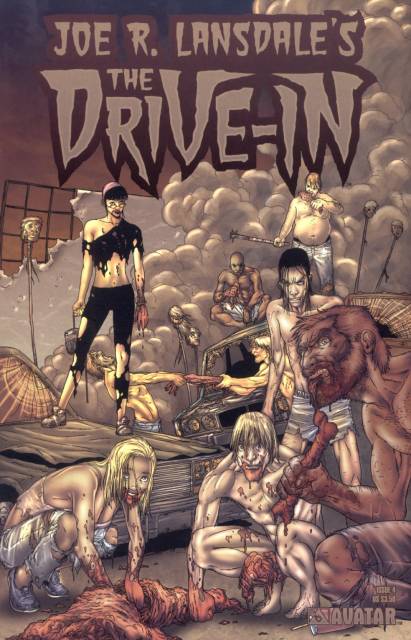
MFR: Do you have a favorite comic adaptation of your work?
JL: I’m pretty damn fond of several. ON THE FAR SIDE OF THE CADILLAC DESERT WITH DEAD FOLKS that Tim did for Avatar was a favorite. There have been some Italian adaptations I really love. Western material of mine, and horror/sci-fi adaptations
MFR: What are you working on now, comic or non-comic related? Anything you want to talk about?
JL: There’s a possible comic that isn’t quite up to bat, yet, but is waiting in the dugout. We’ll see. I’m writing another novel for LITTLE BROWN/MULHOLLAND. I don’t normally talk about something unless I’m finished with it, so nothing to say yet. I do have novels and short story collections coming out. JANE GOES NORTH is out from Subterranean, and a short story collection of Hap and Leonard stories, about their youth, is forthcoming, as well as the stand-alone novel in July, MORE BETTER DEALS from Mulholland Books. And then a collection from Subterranean Press titled FISHING FOR DINOSAURS.
You can check out more information on his official website, The Orbit.

